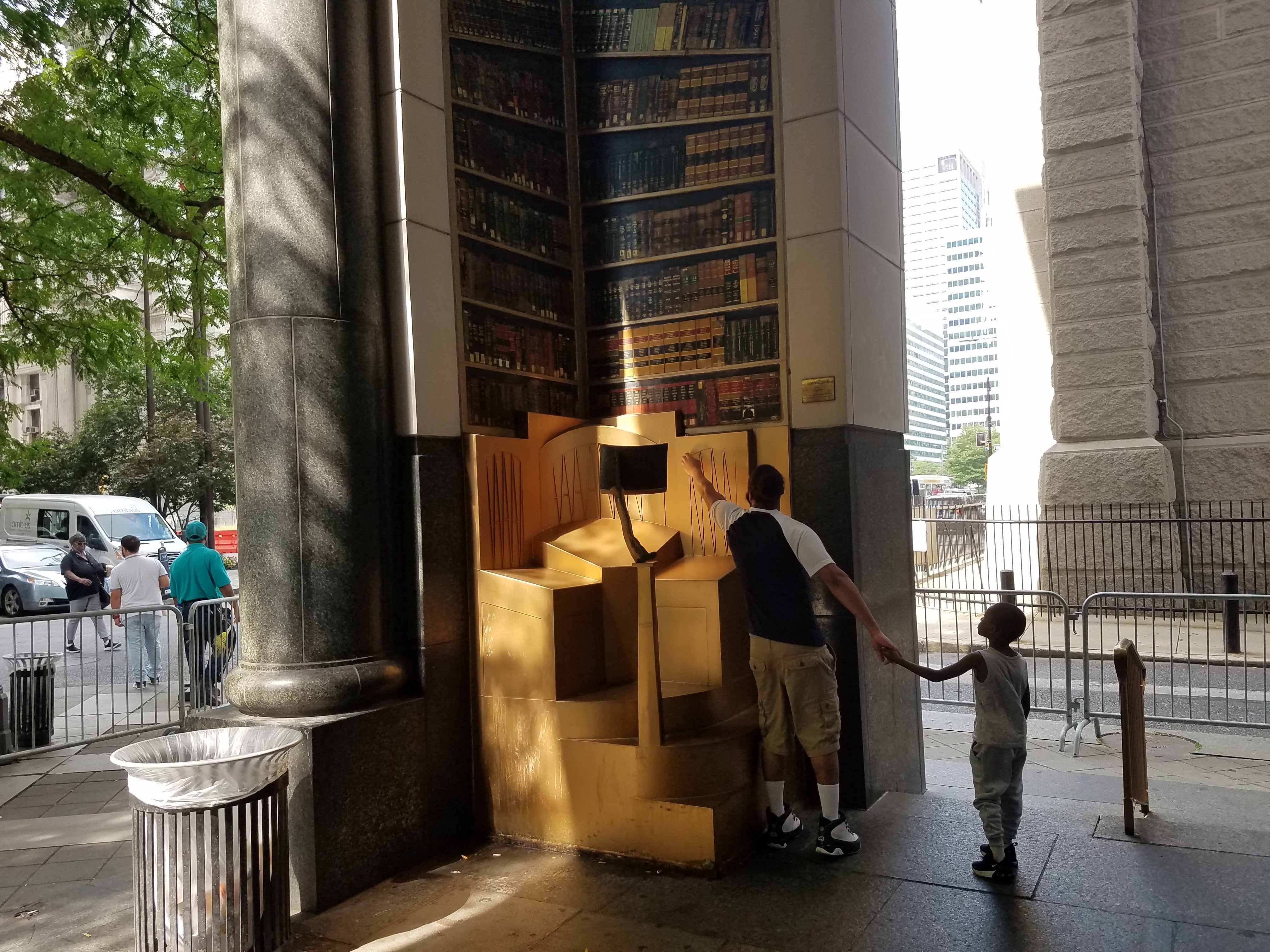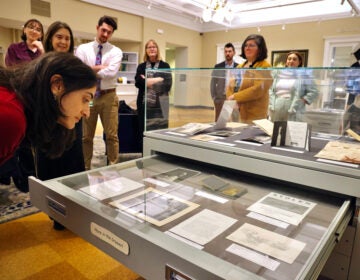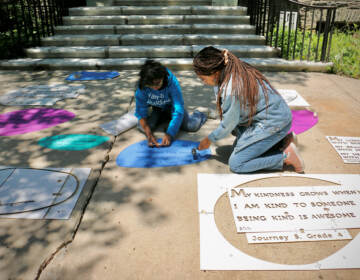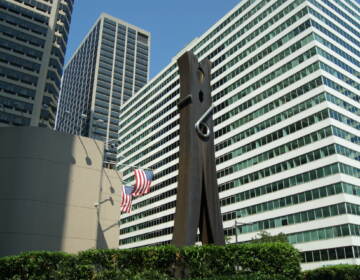Philly’s Percent for Art program — the nation’s first — celebrates 60 years, 600 pieces
Philadelphia’s public art mandate has created more than 600 works in 60 years. Here’s how the program got started and how it’s evolving for a modern city.
Listen 4:30
'Connections' by Athena Tacha. (Philadelphia Redevelopment Authority)
When people enter the Matthias Baldwin Park in Philadelphia’s Logan Square neighborhood, they may not know they are literally walking into a work of art.
The two-acre park was designed by the Greek-American artist Athena Tacha with a huge centerpiece of swirling, tiered plantings and dramatic rock outcroppings. Called “Connections,” it is so large, its curving patterns can only be seen from an aerial view.
Most people will never know the shape of the garden was inspired by the artist’s reading of physics, “where subatomic particles were being described as materialization points of energy,” Tacha once wrote. “Appearing and disappearing, connected to each other through flows of energy.”
“I would hope that the average person, crossing the park routinely, would absorb unconsciously my message,” wrote Tacha.
One of those average people is Sandy Cavanaugh. The backyard of her townhouse abuts the park. While walking her infant grandson and Australian Shepherd, she said she admires it every day.

“It’s fabulous,” said Cavanaugh. “In fact, I see people all the time getting up on the banks to look at the rocks. It looks like Stonehenge.”
The park was built in 1992 by the Franklin Town Corporation, which was also creating a large neighborhood development at the time. The project triggered the city’s Percent for Art requirement, which mandates that any new development involving land acquired through the Philadelphia Redevelopment Authority spend 1% of construction costs on public art.
The program, established in 1959, was the first in the country, and is celebrating its 60th anniversary this summer.
Over the decades, the Percent for Art program has created more than 600 pieces of public art, and inspired other cities to hold developers to similar requirements — with better results. Now, officials are considering ways to make the program more meaningful for the communities it serves.
Public art enhances spaces, instills civic pride
Sixty years ago, Ed Bacon, as director of Philadelphia’s planning commission, was proactively transforming the city’s downtown. In the midst of all the development, the head of the Philadelphia Redevelopment Authority, Michael von Moschzisker, pushed to make sure the new buildings came with aesthetic considerations.
“We’re under an obligation to make sure our cities are places of which we can be proud,” wrote Moschzisker, who served as chair of the PRA from 1956 to 1962.
Gregory Heller, the PRA’s current chair who wrote a book about Bacon, said Moschzisker’s vision was that the authority would “facilitate a mutually beneficial partnership between artists, developers, and architects that would enhance buildings and public spaces.”
Today, there are actually two city Percent for Art programs: one run by the PRA for commercial development, and another run out of City Hall for public capital projects, such as the Criminal Justice Center, built in 1994.
“For this building, there was a $500,000 budget for art — that’s 1% of the city’s total cost,” said Margot Berg, the Director of Public Art in the Mayor’s Office of Arts, Culture, and the Creative Economy.
Berg said the program commissioned multiple artists to create pieces that were “integrated into the architecture” of the building that houses the city’s court system.
Several levels have terrazzo floors embedded with elements that make up maps of the city.
“There are a series of benches on one floor that are specifically intended to lift the spirit of people sitting and waiting to go into court,” said Berg.
One of the facility’s largest commissions is a sculpture outside the entrance, which was built to resemble a law library and made with real books epoxied into shelves stretching 20 feet high.
At the bottom are three brass seats — representing the three figures of criminal argument: the positive, the negative, and the judgement — and a lectern made from a cast of the crack in the Liberty Bell.

In the early 1970s, the artist Phillips Simkin was given permission by the National Park Service to make a mold of the famous bell’s negative space. Simkin, described in his 2013 obituary as “sardonic,” re-used that mold of the Liberty Bell crack over and over in his work, including once casting it in chocolate.
For this piece at the Criminal Justice Center, called “Philada Book of Just Hours,” he may have taken a more serious turn.
“He envisioned this piece to be a forum – either an actual forum or an abstract idea of a forum – for people to talk about the American justice system,” said Berg.
‘Not just art’
Since Philadelphia established the program 60 years ago, the Percent for Art concept has been adopted by many other cities — some of which do it better. That’s according to a 2009 report by Harris Steinberg, then director of PennPraxis at the University of Pennsylvania.
Other cities hold developers to more than a 1% investment in public arts. Some programs are designed with enough flexibility as cities’ economic development planning evolves over time.
Steinberg’s 2009 report, “Philadelphia Public Art: the Full Spectrum,” funded by the William Penn Foundation, said developers in Philadelphia often slipped past the 1% requirement.
“It was easy to skirt the regulations,” said Steinberg, who now directs the Lindy Institute for Urban Renovation at Drexel University. “There wasn’t big staff. There wasn’t a big enforcement arm. In fact, I don’t think there was any enforcement. Because of budget concerns, it was easy to talk your way out of applying art in any meaningful way.”
That report from 10 years ago recommended that the Percent for Art programs be more holistic, and be applied across many city agencies to align more closely to the city’s urban planning goals.
Heller, who came on as director of the PRA three years ago, says the program is moving in that direction.
“One change we’ve made fairly recently is requiring projects to have a public education component,” he said. “Not just art, but art that connects with people and communities in meaningful ways.”
The PRA has also established a Fine Art Fund for developers to pay into if their construction costs are too small to produce a single artwork of any significance to the public, or if they wish to avoid the process of commissioning artwork.
The fund can be used for pieces that are not site-specific to particular developments. An example is “Commotion” in 2012, a six-month festival of performance- and time-based public artwork staged temporarily throughout the Point Breeze neighborhood. Heller said a new effort similar to “Commotion” is in the planning stages, but would not share details.
How to learn more
To celebrate its 60th anniversary, the program is encouraging Philadelphians to discover these pieces of public art with a scavenger hunt. Participants who follow this interactive online map to 60 selected pieces and post pictures with #PercentForArt60 have the chance to win prizes.
Other events, including an exhibition at the Center for Architecture + Design and a panel discussion, are planned for the fall.
WHYY is your source for fact-based, in-depth journalism and information. As a nonprofit organization, we rely on financial support from readers like you. Please give today.





